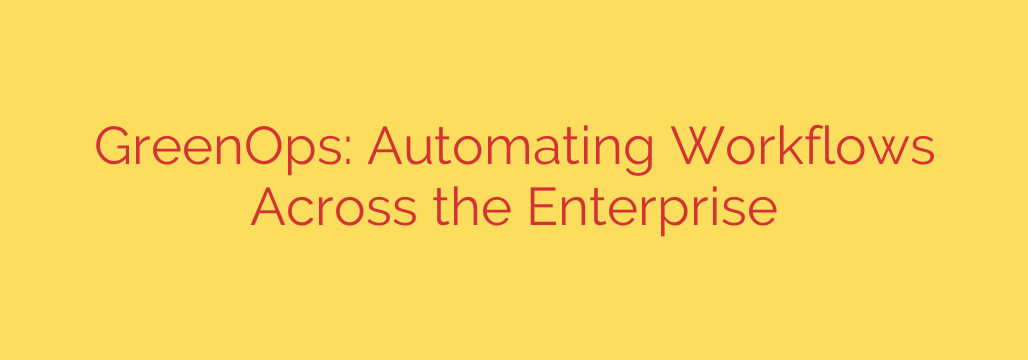
What is GreenOps? Powering Sustainable and Efficient Enterprises Through Automation
In today’s competitive landscape, businesses are navigating a dual mandate: drive operational efficiency to boost the bottom line while demonstrating a strong commitment to sustainability. These goals can often seem at odds, but a new strategic framework is emerging to harmonize them. Enter GreenOps.
Far more than a buzzword, GreenOps is a strategic framework that applies automation and operational best practices to create more sustainable, efficient, and cost-effective business processes. Just as DevOps revolutionized software development by breaking down silos, GreenOps breaks down barriers between operational efficiency and corporate responsibility.
It’s about fundamentally rethinking how work gets done across the enterprise. The core principle is simple: waste, in any form—wasted time, wasted energy, wasted materials, or wasted digital resources—is both expensive and environmentally unfriendly. By systematically identifying and eliminating this waste through intelligent automation, companies can achieve remarkable results.
The Core Pillars of GreenOps
To fully grasp the concept, it’s helpful to understand its foundational pillars. GreenOps is built on a synergistic combination of automation, efficiency, and measurement.
Intelligent Automation at the Core: Automation is the engine of GreenOps. This isn’t just about simple task automation; it’s about deploying sophisticated workflows that connect disparate systems, from HR and finance to supply chain and IT. By automating manual, repetitive, and error-prone tasks, organizations free up human talent for higher-value work and create seamless, low-friction processes.
A Relentless Focus on Efficiency: The “Green” in GreenOps directly refers to the elimination of waste. This includes optimizing resource allocation in cloud computing to prevent “zombie” servers that consume energy without performing work. It also means streamlining supply chains to reduce shipping miles, digitizing paper-based workflows to cut down on physical waste, and refining internal processes to minimize wasted hours.
Sustainability as a Business Outcome: GreenOps reframes sustainability not as a separate, costly initiative, but as a natural outcome of peak efficiency. When you use fewer digital resources, you lower your carbon footprint. When you optimize logistics, you consume less fuel. This approach directly ties environmental, social, and governance (ESG) goals to tangible financial benefits, making sustainability a core part of the business strategy rather than a peripheral one.
Continuous Measurement and Optimization: A core tenet of GreenOps is that you can’t improve what you don’t measure. Implementing this framework requires establishing clear metrics to track resource consumption, process cycle times, and waste reduction. These analytics provide the data needed to continuously refine automated workflows, identify new opportunities for improvement, and demonstrate the ROI of your GreenOps initiatives.
Why GreenOps is a Competitive Advantage Now
The push for smarter, leaner operations is not new, but several factors make GreenOps particularly relevant today.
First, rising energy costs and increasing stakeholder pressure are forcing companies to take a hard look at their operational footprint. Investors, customers, and employees alike are demanding greater transparency and action on ESG goals. GreenOps provides a practical roadmap for meeting these demands.
Second, in a tough economic climate, cost savings are paramount. By eliminating inefficiencies, GreenOps directly reduces operational expenditures. These savings can be realized in reduced cloud computing bills, lower energy consumption, and increased productivity, providing a powerful competitive edge.
Finally, embracing GreenOps can improve brand reputation and attract top talent. Modern professionals want to work for forward-thinking, responsible companies. Demonstrating a commitment to both technological innovation and sustainability makes an organization a more attractive place to work.
How to Get Started with GreenOps: An Actionable Roadmap
Adopting a GreenOps mindset doesn’t require a complete organizational overhaul overnight. It’s a journey of continuous improvement that can begin with a few strategic steps.
Conduct a Waste Audit: Begin by identifying the biggest areas of inefficiency across your enterprise. Where are the bottlenecks? Which processes are heavily reliant on manual data entry or paper? Which departments have the highest cloud spend or energy consumption? Map out your workflows to pinpoint opportunities for automation.
Target Low-Hanging Fruit: Don’t try to automate everything at once. Start with high-impact, low-complexity processes where you can achieve a quick win. This could be automating employee onboarding, streamlining invoice processing, or implementing a cloud cost management tool. Success in these initial projects will build momentum and secure buy-in for broader initiatives.
Deploy and Integrate Automation Solutions: Invest in flexible automation platforms that can connect various applications and systems (like an Enterprise Automation or iPaaS solution). The key is to create a unified ecosystem where data flows seamlessly between departments, eliminating data silos and manual handoffs.
Establish a Cycle of Continuous Improvement: Implement dashboards to track your key GreenOps metrics. Regularly review performance data with stakeholders to identify what’s working and where further optimization is needed. Treat GreenOps not as a one-time project, but as an ongoing operational discipline.
By embracing GreenOps, organizations can finally align profitability with purpose, building a more resilient, efficient, and sustainable enterprise for the future.
Source: https://collabnix.com/from-devops-to-greenops-automating-workflows-beyond-it/








